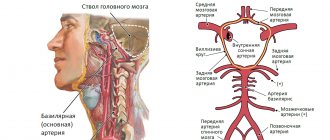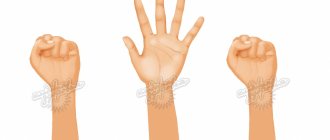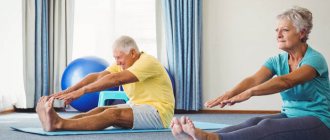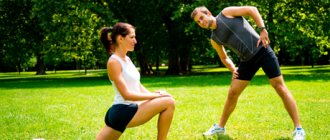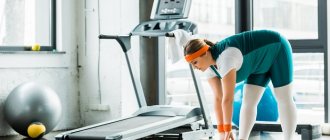Millions of people around the world lead a sedentary lifestyle. Often they don’t have the strength to go to the gym or even work out at home. If you live according to the “work-home-home-work” pattern, this is not an excuse. You can keep fit even in the office. This will take literally 10-15 minutes, and colleagues may not even notice your increased activity in the workplace.
Tilt the head from side to side (you can add head rotation to the right and left). This good old exercise, familiar from school times, helps improve blood circulation and stretch a tired cervical spine. We do bends 8-12 times.
Photo: istockphoto.com
What human organs are affected by long periods of sitting?
Sitting for long periods of time without breaks is harmful to our health. Plus, many of us do not sit as well as we should in order to reduce ongoing risks to humans. After all, everything in our body is interconnected; it is a system in which most parameters are automatically regulated. The entire body is entangled in feedback systems, when some organs influence the work of others. I gave an example a little higher. I repeat:
If the brain lacks oxygen, it commands the heart to increase its Heart Rate. The heart begins to pump blood at an accelerated rate. When the brain gets enough oxygen, it gives the command to work at this frequency, the heart works at this frequency. The man decided to rest and lay down on the sofa. There is a lot of oxygen, the brain doesn’t need that much when resting, and heart rate drops to a minimum.
And thus, constantly and without rest, our internal organs interact with each other. In technology, automatic control systems work this way, in this mode, where necessary, with positive feedback, and where necessary, with negative feedback. But our body is hundreds of times more complex than any technical automatic systems. And let's move on to specifics, namely, what happens to our body when we sit.
Poor circulation in the legs when sitting for long periods of time
Let's start from the feet and work our way up. When we sit and our legs, right up to the popliteal fossae, lie on the seat of a chair or armchair, they compress the blood vessels and lymph nodes. Stagnation begins to occur in them. What are they due to? Yes, by pinching blood vessels. The veins in the legs suffer from constriction because we squeeze them with our weight.
And if your feet are not yet on the floor, but are suspended, this is very bad. Blood circulates poorly, which is why after sitting for a long time we cannot walk normally; half-dead legs begin to obey us normally only when normal blood flow is restored in them.
Poor circulation in the pelvic and gastrointestinal tract
When we sit, the body temperature in the pelvic area increases due to the compression effect, since it is difficult to remove heat at the point of contact between the body and the stool. This causes blood to stagnate in the pelvic area. Internal organs are compressed, blood flow within the pelvic organs is obstructed. The intestines and rectum are deformed.
If a person spends a lot of time sitting, and sits incorrectly, this can lead to the development of varicose veins of the legs and blood nodes of the rectum. At the same time, the muscles of the rectum will weaken, and all this guarantees us hemorrhoids, and by the age of forty, prostatitis in men and diseases of the female organs in women. But that's not all. This uncomfortable body position causes us problems with the intestines, that is, constipation will bother us more and more. And stomach problems will appear.
Load on the spine in the lumbar region
Next we move on to the lumbar region. Incorrect curvature of the spine in the lumbar region leads to future back pain. The spine is bent, and remains in this position until you get up from a chair or armchair, straightening it. What is a curved spine? These are improperly compressed intervertebral discs and compressed blood vessels of the spinal column.
What does this lead to? This leads to the fact that not enough blood, nutrients and oxygen will flow to a certain organ. A constant lack of oxygen can cause organ disease. To avoid this, it is necessary not to squeeze the blood vessels.
Thoracic: Belly breathing prolongs life
Next comes the thoracic region. Which also experiences stress on the spine in its area. And the thoracic region is the ribs movably attached to the spine, that is, the chest. And if it is in the wrong position for a long time, then it is simply compressed and its volume decreases as a result, that is, the capacity of the lungs decreases.
If your lung capacity decreases, then you breathe more often; the more often you breathe, the greater the load on the body. This is such a simple mechanic. I don’t touch on many other factors, I’m not a doctor, but the above is enough to understand that by not paying attention to our position, we risk our health. And if this whole matter is also complicated by thoracic osteochondrosis, then difficulty in breathing, burning in the chest, and pain between the shoulder blades are added.
Cervical spine and impaired blood flow in it
I wrote about the neck above, and there is nothing special to add, except that if you have cervical osteochondrosis, then the blood flow in the neck can be reduced several times, and the brain constantly experiences hypoxia. And if you have frequent headaches, it is most likely caused by a lack of oxygen. And there may be several reasons for this. And I, at one time, felt this myself.
What are the dangers of cerebral circulatory disorders?
I'll tell you a story from my life. This was several years ago. Every day I had a severe headache. It started at about 9-10 in the morning and until 20 in the evening. The rest of the time she was also sick, but less. I had tests done and they were relatively normal. But there was high blood pressure. This lasted for about half a year, no less. With each trip to the doctor, I was prescribed more and more pills, but nothing changed.
The doctor was diligent, responsible, and approached treatment meticulously. He prescribed medications for blood pressure, I took them, it dropped below the required level, and I almost fell over it myself. Then something else was prescribed, and my blood pressure jumped high, I almost fell again, this time from something else. He didn't even have enough time to really listen to me. He kept inventing schemes for feeding me pills.
At the appointment I told him: “Doctor, my head still hurts,” he says: “Uh-huh,” and writes something further on the card. I told him again: “What should I do? I’m already climbing the walls!” He says, “uh-huh,” and then writes. I tell him the same thing for the third time. And he silently looks at me, with his hands and face, points to the recipe, like, don’t interfere, I’m just writing you a new recipe.
It already contained 12 different types of tablets: some are taken in 2 pieces. four times a day before meals, others one three times after meals, others half a tablet, four times a day. It came down to quarters. And then I finally realized that saving drowning people is the work of the drowning people themselves. I stopped drinking all this nonsense. I saved myself from headaches with citramone. Stronger painkillers did not help.
And somehow it so happened that very soon life brought me to one person who advised me to use a breathing simulator. And I grabbed onto it. And a month later I already looked at life much more cheerfully. And after a couple of months I began to forget about the headaches.
Not only oxygen is dissolved in our blood, but also carbon dioxide, which is involved in metabolism in the body. And if the carbon dioxide content in the blood is below normal, then the blood cannot give the cells all the oxygen that is dissolved in it. And with age, carbon dioxide in the blood becomes less and less.
And this simulator helps to increase the level of carbon dioxide in the blood, first by force, and then the body begins to produce the norm itself, to enter the regime prescribed to it from birth. All that remains is to periodically “remind” him of this, breathing through it for 20-30 minutes several times a week. You can do it more often, it won’t get worse. But that is another story.
Exercises
Exercises in the office are done from different starting positions. Choose those that are convenient for you. The main thing is to distribute the load across all parts of the body, focusing special attention on the most painful one (for example, the back).
Industrial gymnastics exercises can be static and dynamic. When performing static exercises (not requiring active movements), fix the selected position for 20 seconds. During dynamic training, movements are repeated 10-15 times.
- Sit in a comfortable position. Tilt your head first to your right shoulder, then to your left.
- Slowly rotate your head, first in one direction, then in the other.
- Join your palms into a lock, “turn it over” and stretch your arms forward, thoroughly stretching all the muscles.
- Place your hands behind your back, clasping your palms together. Straighten your shoulders, pulling them and your head back behind your hands.
- Sitting on a chair, place your head on your knees and lower your hands to your feet. Feel the stretch in your back muscles.
- Sit down. Place your hands behind the chair, placing your palms together. Stretch your shoulder muscles.
- Bend your right arm at the elbow. “Insert” the elbow of your left hand into the resulting elbow “pocket.” Pull your arm to the right, developing the shoulder girdle. Then repeat the same on the other side.
- Place your hands on your knees. Bend your head and, rounding your back, stretch your back muscles with rocking movements.
- Stretch as if after waking up, stretching your arms straight up.
- Stand facing the back of a chair. Grasp it with outstretched arms. Bend deeply so that your back is straight.
- Stand up. Keeping your back as straight as possible, tilt your torso to the right and left, accompanying the movements with swings of your arms above your head.
- Come to the table. Rest your hands on its edge. Do push-ups.
- Sitting on a chair, raise your legs and rotate them as if you were riding a bicycle.
- Squat down, keeping your back as straight as possible and extending your arms forward.
What to pay attention to
A person can select exercises to perform in the office himself, without the participation of a doctor. When choosing, you need to consider the following points:
- What position is the employee most often in?
- Specifics of movement of arms or legs during work;
- Nature of activity (mental, emotional, nervous, precise, repetitive);
- The degree and characteristics of fatigue (headache, muscle weakness, apathy, aggression);
- The presence or absence of chronic diseases;
- The sanitary condition of the workplace and conditions for conducting classes.
Vorobyov’s gymnastics, hidden from prying eyes: for those who are often at the computer
Sometimes a person does not have the conditions or opportunities to train at work. Hidden gymnastics were developed especially for such situations.
- Lift your heels off the floor with sudden movements. In 1 minute you need to make up to 40 “breaks”.
- Repeat the movement, lifting your socks off the floor. In 1 minute you need to make up to 40 “breaks”.
- Make sequential movements, squeezing and unclenching the muscles of the buttocks, up to 40 times per 1 minute.
- Inhale and inflate your belly. As you exhale, pull your stomach in as much as possible for 6 seconds. Then relax. Slowly repeat the movements until you feel tired.
- Clench and unclench your fingers tightly into fists.
Regularly performing these simple movements will provide you with a good mood and excellent health, and will increase your work efficiency.
A set of strength exercises
This gymnastics has 3 levels of difficulty. The first involves performing exercises in 3 approaches, the second – 5, the third – 7.
- Stand near a chair. Squat over it so that your buttocks do not touch the seat. Keep your arms straight with your palms clasped.
- Sitting straight on a chair, extend your arms straight forward. Connect and separate them sharply, imitating the movements of scissors.
- Sitting on a chair with your back straight, lift your straight legs one at a time. Hold them above the floor level for 10-15 seconds. Make sure they don't bend at the knees.
- Sitting on a chair with your back as straight as possible, place your hands on the back of your head, clasping your fingers. Bend your torso to the right and left.
- Sitting on a chair with your back as straight as possible, slowly bend your knees, pulling them up. This is how you pump up your abs.
Preparation for classes
In order for physical exercise during working hours to really bring benefits, you need to prepare both yourself and your workplace:
- First, you should ventilate the room ; before performing the complex, you need to enrich the room with oxygen so that the exercise is effective and healthy.
- Do not overuse air conditioners and heaters . Air conditioners contribute to hypothermia and drying of the air, while heaters, on the contrary, overheat the air and also reduce the level of moisture. And not only for gymnastics, but also to ensure a normal work process, the air temperature should be within 15-25 degrees.
- To ensure that exercise is effective and safe, exercise in the correct clothing and shoes . The fabric should not hinder movement, and shoes should not contribute to injury, for example, high-heeled shoes. Therefore, if you want to study at the workplace, think about at least a change of shoes.
- You cannot start your working day with intense loads and physically difficult exercises, as high energy costs will reduce your performance, and you will not get anything from such exercises during the day except fatigue.
- Under no circumstances should you eat food immediately before or after charging . You can drink a glass of water half an hour before performing the complex and after it is completed.
Plank
The plank is a universal and relatively simple exercise that uses almost all important muscle groups.
A daily two-minute plank can correct your figure and improve your well-being. The plank is a static exercise. There are no movements in it, so the most important thing here is to hold the body correctly (and for as long as possible). Stand on your elbows, straighten your knees, and rest your feet only on your toes. The body should visually depict a straight line so that no part of it protrudes upward: neither the shoulder blades, nor the hips, nor the buttocks. If it is difficult for you to stand in this position for a long time, you can lighten the load slightly by kneeling, but with your feet raised.
gsclinic.ru
Walking
The simplest and most obvious exercise. Walking is a great form of movement for people with a sedentary lifestyle, so try to walk as much as possible every chance you get. Walking during your lunch break, to the bus stop, instead of public transport, or just in circles in your office office - any option is good. By the way, walking is an excellent change of activity after intense intellectual work. If you think long and hard about something, it will be much easier for you to make a decision by walking down the corridor for 5-10 minutes.
zen.yandex.ru


